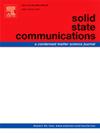Effect of rare earth doping on structural, morphological, optical, and magnetic properties of the Y1-x(Gd, Dy)xBaCuFeO5 (x = 0.2, 0.4, 0.6, and 0.8) ceramics
IF 2.1
4区 物理与天体物理
Q3 PHYSICS, CONDENSED MATTER
引用次数: 0
Abstract
The effect of the rare earth (RE) ion substitution on the structural, morphological, optical and magnetic properties of the Y1-xRExBaCuFeO5 (RE = Gd, Dy; x = 0.2, 0.4, 0.6, and 0.8) multiferroic compounds grown by the solid-state reaction is evaluated using X-ray diffraction (XRD), scanning electron microscopy (SEM), dispersive X-ray spectroscopy (EDX), reflectance spectroscopy techniques diffuse (UV–vis–NIR) and vibrating sample magnetometry (VSM). The results indicate that the RE substitution led to growth of single-phase materials, with a tetragonal structure and P4mm symmetry. The morphological analysis shows the formation of polycrystalline materials composed of grains of various shapes and sizes. Furthermore, the compositional analysis reveals that the materials do not present elements other than those used in the synthesis. The band gap (Eg) is tuned from 0.88 to 0.90 eV upon RE substitution. The magnetization curves obtained in the Zero-Field-Cooled/Field-Cooled (ZFC-FC) modes between 50 and 390 K, reveal a paramagnetic behavior, which could be attributed to the dominance exerted by the magnetic moments of the Gd/Dy ions.
稀土掺杂对 Y1-x(Gd,Dy)xBaCuFeO5(x = 0.2、0.4、0.6 和 0.8)陶瓷的结构、形态、光学和磁学特性的影响
利用 X 射线衍射 (XRD)、扫描电子显微镜 (SEM)、色散 X 射线光谱 (EDX),评估了稀土 (RE) 离子替代对固态反应生长的 Y1-xRExBaCuFeO5(RE = Gd、Dy;x = 0.2、0.4、0.6 和 0.8)的多铁化合物进行了评估,评估采用了 X 射线衍射 (XRD)、扫描电子显微镜 (SEM)、色散 X 射线光谱 (EDX)、漫反射光谱技术(UV-vis-NIR)和振动样品磁力计 (VSM)。结果表明,RE 替代导致了单相材料的生长,这种材料具有四方结构和 P4mm 对称性。形态分析表明形成了由各种形状和大小的晶粒组成的多晶材料。此外,成分分析表明,除合成过程中使用的元素外,材料中不存在其他元素。取代 RE 后,带隙(Eg)从 0.88 eV 调整到 0.90 eV。在 50 至 390 K 之间的零场冷却/场冷却(ZFC-FC)模式下获得的磁化曲线显示出顺磁性,这可能是由于 Gd/Dy 离子的磁矩占主导地位。
本文章由计算机程序翻译,如有差异,请以英文原文为准。
求助全文
约1分钟内获得全文
求助全文
来源期刊

Solid State Communications
物理-物理:凝聚态物理
CiteScore
3.40
自引率
4.80%
发文量
287
审稿时长
51 days
期刊介绍:
Solid State Communications is an international medium for the publication of short communications and original research articles on significant developments in condensed matter science, giving scientists immediate access to important, recently completed work. The journal publishes original experimental and theoretical research on the physical and chemical properties of solids and other condensed systems and also on their preparation. The submission of manuscripts reporting research on the basic physics of materials science and devices, as well as of state-of-the-art microstructures and nanostructures, is encouraged.
A coherent quantitative treatment emphasizing new physics is expected rather than a simple accumulation of experimental data. Consistent with these aims, the short communications should be kept concise and short, usually not longer than six printed pages. The number of figures and tables should also be kept to a minimum. Solid State Communications now also welcomes original research articles without length restrictions.
The Fast-Track section of Solid State Communications is the venue for very rapid publication of short communications on significant developments in condensed matter science. The goal is to offer the broad condensed matter community quick and immediate access to publish recently completed papers in research areas that are rapidly evolving and in which there are developments with great potential impact.
 求助内容:
求助内容: 应助结果提醒方式:
应助结果提醒方式:


